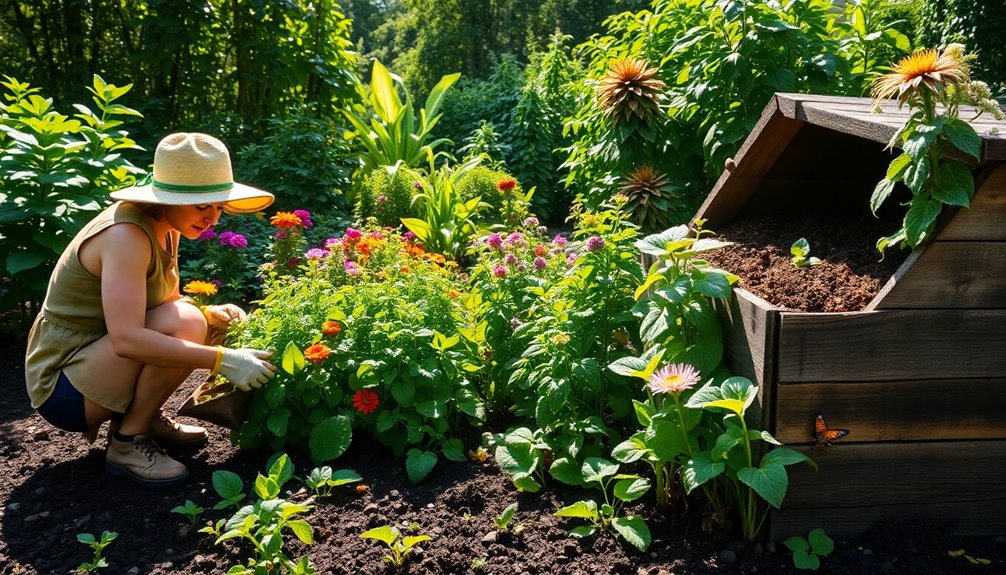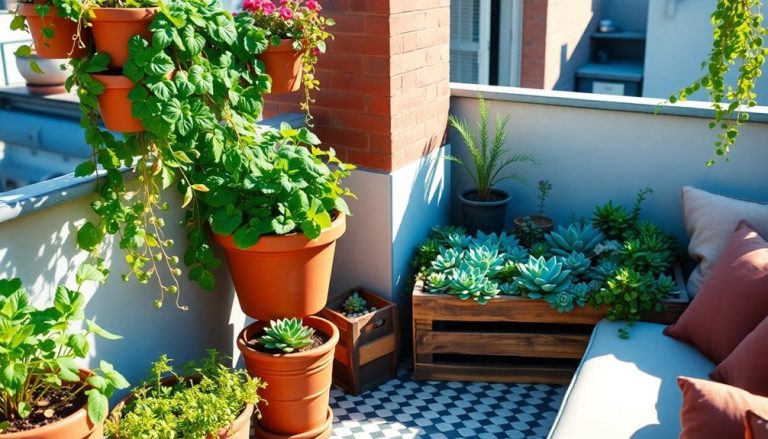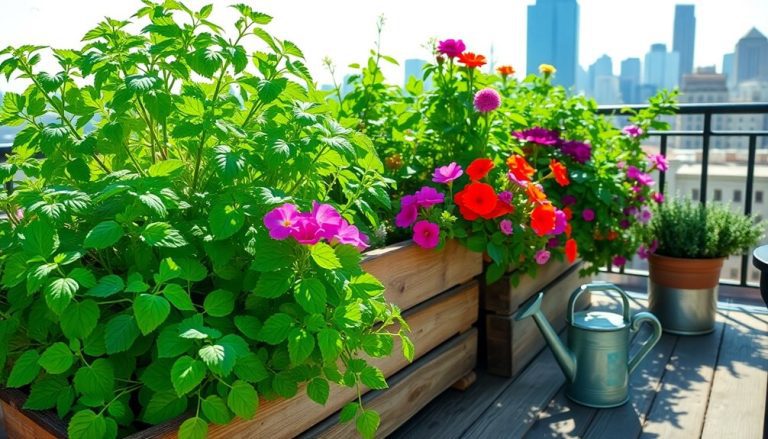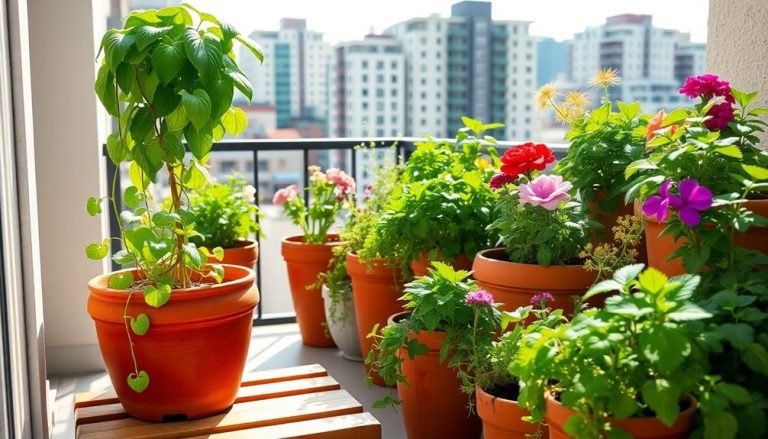To ensure your organic garden thrives, start by choosing native plants that suit your local environment. Practice crop rotation to boost soil health and prevent pests. Regularly improve your soil with organic matter and fertilizers, and water wisely using deep, infrequent techniques. Effective mulching helps retain moisture while suppressing weeds. Encourage beneficial insects by planting a variety of flowers and herbs, and always maintain garden hygiene by clearing debris. Lastly, be mindful of weather changes to adjust your care routine. Implementing these best practices will elevate your gardening experience, and there's so much more to explore!
Key Takeaways
- Choose native plants to enhance biodiversity and reduce resource needs, promoting a resilient and low-maintenance garden.
- Incorporate organic fertilizers like compost and well-aged manure to improve soil health and support microbial activity.
- Implement natural pest management strategies by attracting beneficial insects and using eco-friendly practices like neem oil.
- Use deep, infrequent watering techniques and mulch to conserve moisture and protect plants from stress.
- Practice crop rotation and monitor weather conditions to optimize planting schedules and maintain soil fertility.
Choose Native Plants
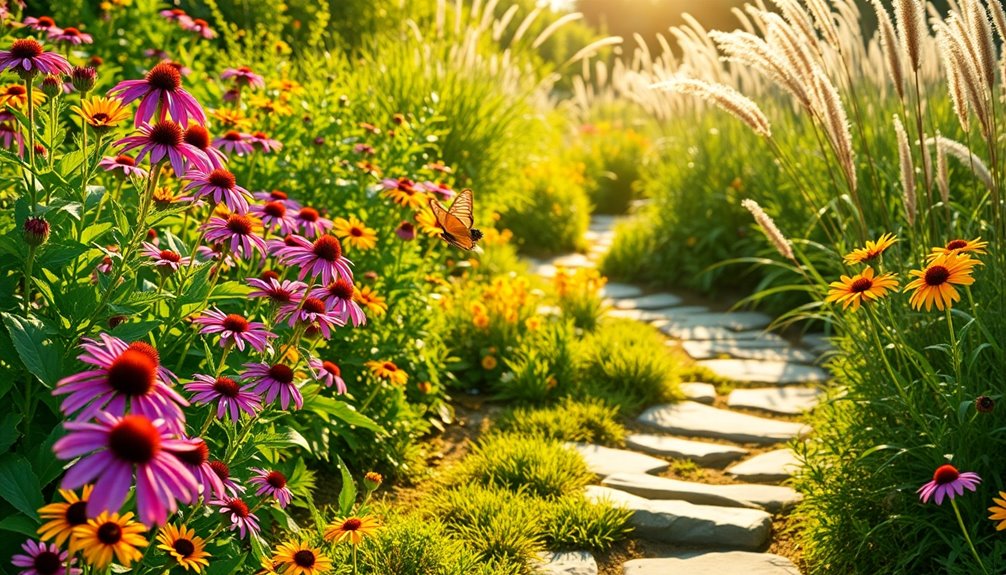
Choosing native plants is one of the smartest decisions you can make for your organic garden. These plants are adapted to your local climate and soil conditions, which means they require less water and fewer resources to thrive.
By selecting native species, you'll create a garden that's more resilient to pests and diseases, reducing the need for chemical interventions. Additionally, native plants often have natural pest deterrents that further enhance their ability to thrive without synthetic pesticides.
Native plants also support local wildlife, providing essential habitats and food sources for pollinators, birds, and beneficial insects. This not only enhances biodiversity but also helps maintain a healthy ecosystem in your garden.
When you choose native plants, you're promoting a balance that naturally controls pests, making your gardening efforts more effective. Additionally, incorporating insect-repelling plants can further enhance your garden's defense against pests.
Moreover, native plants tend to be low-maintenance, saving you time and effort. They're accustomed to the local environment, meaning they'll flourish with minimal intervention.
You'll find that once established, these plants can create a stunning display of colors and textures without the need for constant care.
Practice Crop Rotation
Crop rotation is a vital practice in organic gardening that can significantly enhance soil health and boost your yield. By changing the location of your crops each season, you can reduce pest issues and nutrient depletion, leading to a more productive garden. Additionally, using quality soil products can further improve the effectiveness of your crop rotation strategy.
Here's how to effectively implement crop rotation:
- Group by Family: Plant different vegetable families in rotation. For instance, follow leafy greens with root vegetables, which use different nutrients.
- Plan for Seasons: Rotate crops seasonally. In spring, you might start with legumes, then move to brassicas in summer, and finally to nightshades in fall.
- Observe Soil Needs: Pay attention to the nutrient needs of your plants. Some crops fix nitrogen, while others consume it, so plan accordingly.
- Monitor Pests and Diseases: Keep an eye on pest cycles. Rotating crops can disrupt their life cycles, reducing infestations. Additionally, incorporating organic mulching materials can further enhance soil moisture retention and suppress weeds, complementing your crop rotation efforts.
Improve Soil Health
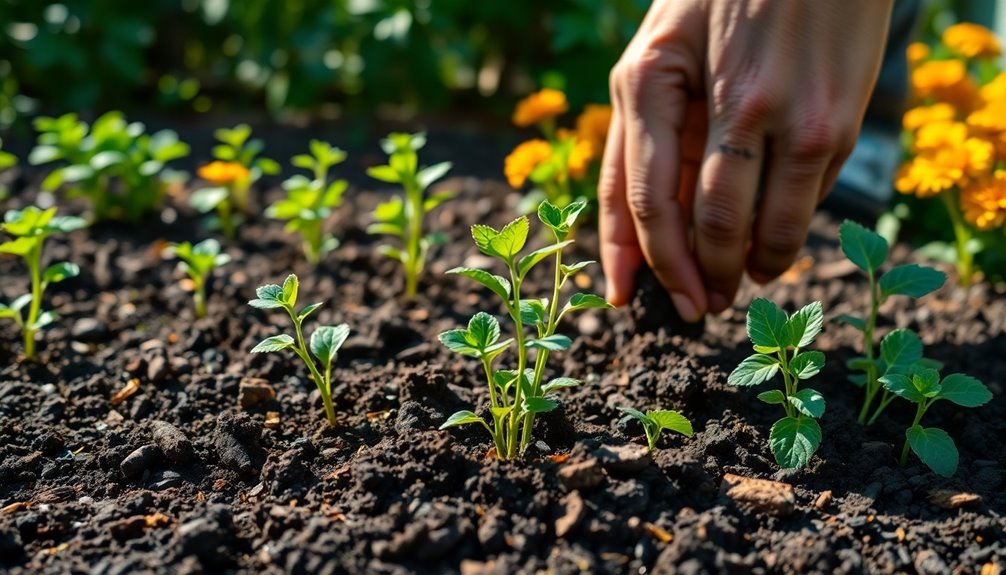
Healthy soil is the foundation of a thriving organic garden, and improving it can lead to increased plant vigor and higher yields. To start, focus on adding organic matter, like compost or well-rotted manure, to enrich your soil. This not only provides essential nutrients but also enhances soil structure and moisture retention. Additionally, using a quality compost bin can streamline the composting process and provide you with rich organic matter more efficiently.
Next, consider incorporating cover crops during the off-season. These plants prevent erosion, suppress weeds, and fix nitrogen in the soil. When tilled back into the ground, they contribute organic matter and improve soil fertility.
Don't forget to perform regular soil tests. Knowing your soil's pH and nutrient levels helps you tailor your amendments effectively. If your soil is too acidic, adding lime can balance it out, while sulfur can lower pH if it's too alkaline.
Lastly, practice minimal tilling. Over-tilling can disrupt soil structure and harm beneficial microorganisms. Instead, use tools like a broadfork to aerate the soil without disturbing its layers.
Use Organic Fertilizers
How can you ensure your plants get the nutrients they need without relying on synthetic options? Using organic fertilizers is the answer!
These natural alternatives not only nourish your plants but also enrich the soil, promoting a healthy ecosystem.
Here's how you can incorporate organic fertilizers into your garden care routine:
- Compost: Create your own compost using kitchen scraps and yard waste. This nutrient-rich mix improves soil structure and boosts microbial activity.
- Manure: Use well-aged manure from herbivores like cows or horses. It's packed with nutrients and adds organic matter to the soil.
- Bone Meal: This slow-releasing fertilizer is high in phosphorus, promoting strong root development and blooming. Sprinkle it around your plants as needed.
- Fish Emulsion: A liquid fertilizer that's easy to apply, fish emulsion provides a quick nutrient boost, especially beneficial during the growing season.
Implement Companion Planting
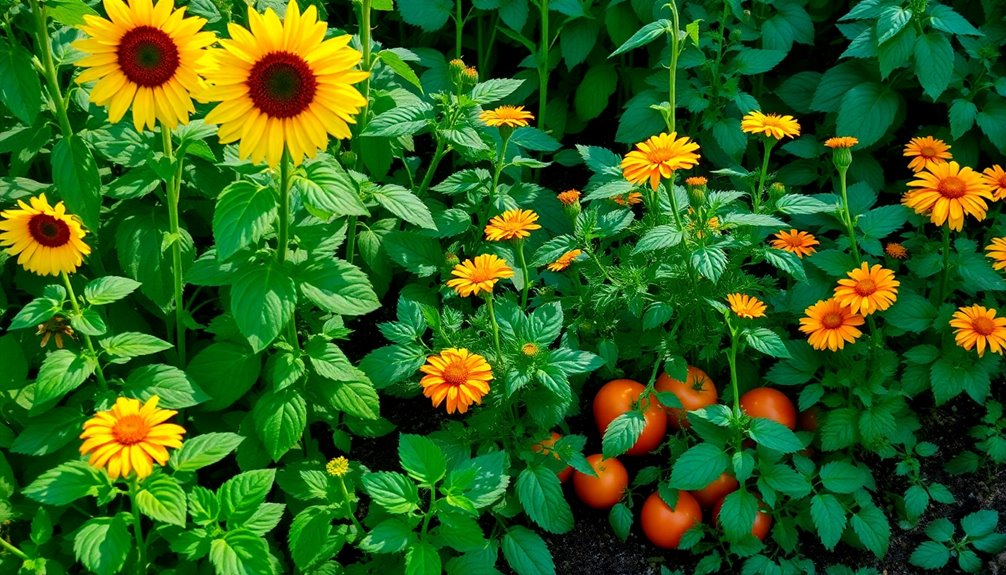
Implementing companion planting can significantly enhance your garden's health and productivity. By strategically pairing plants, you create a harmonious ecosystem that benefits both your crops and the surrounding environment. For instance, planting marigolds alongside vegetables can deter harmful pests while attracting beneficial insects.
You should consider the growth habits and nutrient needs of each plant when deciding on your pairings. Tall plants, like sunflowers, can provide shade for smaller, shade-loving varieties. Meanwhile, legumes, such as beans, can enrich the soil with nitrogen, benefiting nearby plants that require this nutrient.
Another great pairing is basil with tomatoes. Basil not only enhances the flavor of tomatoes but also helps repel pests that commonly afflict them. Similarly, planting carrots and onions together can confuse pests, reducing the likelihood of infestations.
As you plan your garden layout, take the time to research compatible plants and their benefits. This approach not only maximizes space but also promotes robust growth and yields.
With careful selection and planning, companion planting can lead to a flourishing garden that thrives naturally, making your gardening experience even more rewarding.
Manage Pests Naturally
Utilizing natural methods to manage pests can protect your plants without harmful chemicals.
By adopting eco-friendly practices, you not only ensure the health of your garden but also contribute to a balanced ecosystem.
Here are four effective strategies to keep pests at bay:
- Introduce Beneficial Insects: Ladybugs and lacewings are natural predators of aphids and other harmful pests. Encourage them by planting nectar-rich flowers.
- Use Neem Oil: This natural pesticide disrupts pests' life cycles without harming beneficial insects. Mix it with water and spray it on affected plants.
- Create Barriers: Use row covers or fine mesh to physically block pests from reaching your plants. This method is especially effective for crops like cabbage and lettuce.
- Encourage Biodiversity: Plant a variety of species in your garden. This not only attracts beneficial insects but also makes it harder for pests to thrive.
Water Wisely
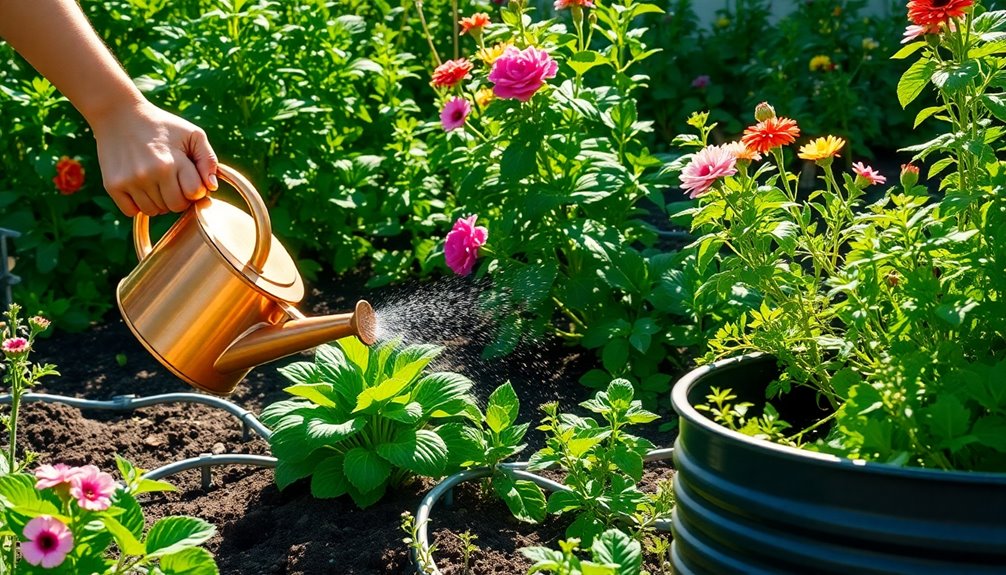
Watering your garden effectively is crucial for maintaining healthy plants and conserving resources. Start by assessing your soil type; sandy soils drain quickly, while clay retains moisture longer. This understanding helps you determine how often to water.
Generally, aim for deep, infrequent waterings rather than shallow, frequent ones. This encourages roots to grow deeper, making your plants more resilient.
Time your watering wisely, too. Early morning is the best time, as it allows plants to absorb moisture before the heat of the day. If you can't water in the morning, late afternoon works as well, but avoid evening watering to reduce the risk of fungal diseases.
Use a soaker hose or drip irrigation system to deliver water directly to the roots, minimizing evaporation and runoff. If you're hand watering, aim for the base of the plants instead of the foliage.
Regularly check the moisture level in your soil by sticking your finger about an inch deep; water only when it feels dry.
Finally, keep an eye on the weather. If rain is expected, skip your scheduled watering to save water and benefit your plants.
Mulch Effectively
While you might think of mulch as just decorative, it plays a vital role in maintaining an organic garden.
Mulching helps conserve moisture, suppress weeds, and improve soil health. To mulch effectively, follow these simple steps:
- Choose the Right Material: Use organic materials like straw, wood chips, or shredded leaves. These break down over time, enriching your soil.
- Apply the Right Thickness: Aim for a 2-4 inch layer of mulch. This depth retains moisture without smothering your plants.
- Keep it Away from Stems: Ensure you leave a small gap around the base of your plants. This prevents rot and keeps pests at bay.
- Refresh Regularly: As mulch decomposes, replenish it to maintain that ideal depth. This keeps your garden looking neat and healthy.
Encourage Beneficial Insects
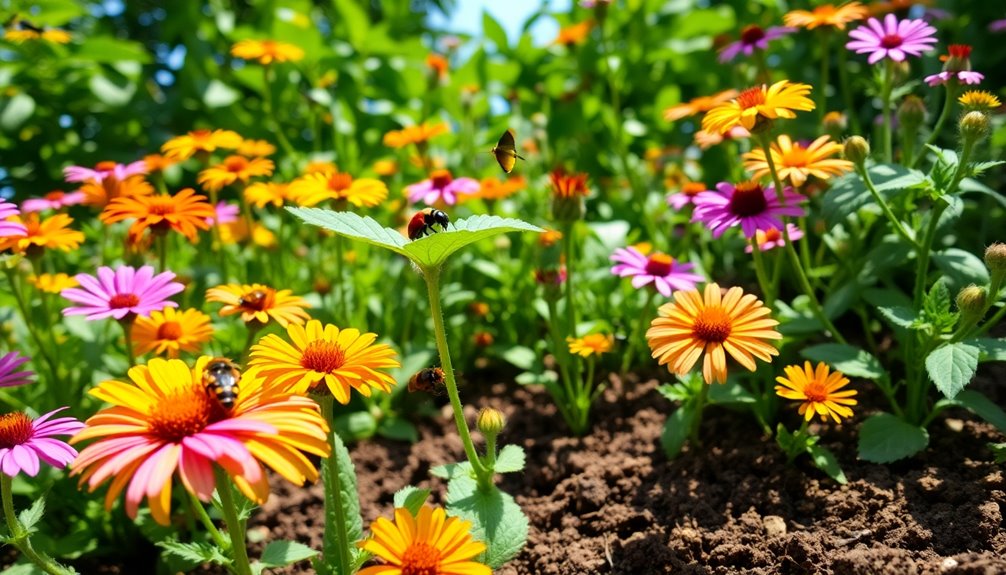
Attracting beneficial insects to your organic garden can significantly enhance its health and productivity. These helpful creatures, like ladybugs, lacewings, and parasitic wasps, are natural predators of pests that can damage your plants.
To encourage them, start by creating a diverse habitat. Plant a variety of flowers and herbs, as many beneficial insects are attracted to nectar and pollen. Consider incorporating flowering plants such as dill, fennel, and marigolds to provide food sources for these insects.
You can also create shelter for beneficial insects by leaving some areas of your garden undisturbed. Piles of leaves or small brush piles can serve as homes for these helpful allies.
Avoid using chemical pesticides, as they can harm beneficial insects along with pests. Instead, opt for organic pest management techniques that protect these allies while keeping your garden healthy.
Finally, try to maintain blooming plants throughout the growing season. This ensures a consistent food supply for beneficial insects, encouraging them to stick around.
Maintain Garden Hygiene
Maintaining garden hygiene is essential for the overall health of your organic garden. A clean garden helps prevent pests and diseases, creating a thriving environment for your plants.
Here are some best practices to keep your garden tidy:
- Remove Debris: Regularly clear away dead leaves, fallen fruit, and other debris. This reduces hiding spots for pests and prevents fungal diseases.
- Clean Tools: After each gardening session, wash your tools to remove soil and plant residue. Sanitize them occasionally to avoid spreading diseases between plants.
- Rotate Crops: Practice crop rotation to maintain soil nutrients and prevent the buildup of pests and diseases in the same area. This keeps your garden ecosystem balanced.
- Compost Wisely: Use a well-maintained compost pile for organic waste. Ensure it's hot enough to kill pathogens, and avoid adding diseased plants to prevent contamination.
Frequently Asked Questions
How Do I Start an Organic Garden From Scratch?
To start an organic garden from scratch, choose a sunny spot, prepare the soil, select organic seeds or seedlings, and water regularly. Keep weeds at bay and monitor for pests to ensure healthy growth.
What Tools Are Essential for Organic Gardening?
To succeed in organic gardening, you'll need essential tools like a hand trowel, pruning shears, a hoe, a rake, and a watering can. These tools help you cultivate, maintain, and nurture your garden effectively.
Can I Use Seeds From Non-Organic Plants?
You can use seeds from non-organic plants, but they might not carry the same benefits. By choosing organic seeds, you'll increase your chances of growing healthier plants that thrive in your garden's ecosystem.
How Do I Know if My Plants Are Healthy?
To know if your plants are healthy, check their leaves for discoloration or spots, observe their growth patterns, and assess soil moisture. Healthy plants typically exhibit vibrant colors and sturdy stems, indicating they're thriving.
What Common Mistakes Should Beginners Avoid in Organic Gardening?
When you start organic gardening, avoid overwatering, using synthetic fertilizers, neglecting soil health, and planting too closely together. These common mistakes can hinder your plants' growth and overall garden success. Stay patient and learn as you grow!
Conclusion
By choosing native plants, practicing crop rotation, and improving soil health, you're setting your organic garden up for success. With organic fertilizers, companion planting, and wise watering, you're nurturing a vibrant ecosystem. By mulching effectively, encouraging beneficial insects, and maintaining garden hygiene, you're creating a thriving environment. Embrace these best practices, and watch your garden flourish with life, color, and abundance. Your dedication to organic care will reap rewards season after season.

